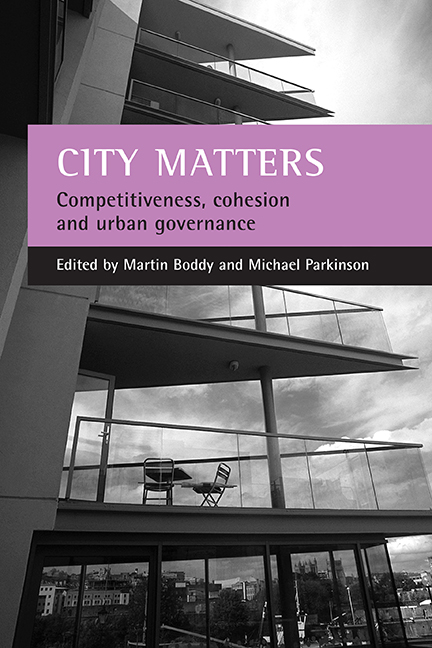Book contents
- Frontmatter
- Contents
- List of tables and figures
- Foreword
- Acknowledgements
- Notes on contributors
- one Introduction
- Part One Competitiveness, cohesion and urban governance
- Part Two Competitiveness and urban change
- Part Three Competitiveness, innovation and the knowledge economy
- Part Four Housing, property and economic performance
- Part Five Space, place and social cohesion
- Part Six Ethnicity, enterprise and social cohesion
- Part Seven Leadership, governance and social capital
- Conclusions
- Index
eight - Cities are not isolated states
Published online by Cambridge University Press: 20 January 2022
- Frontmatter
- Contents
- List of tables and figures
- Foreword
- Acknowledgements
- Notes on contributors
- one Introduction
- Part One Competitiveness, cohesion and urban governance
- Part Two Competitiveness and urban change
- Part Three Competitiveness, innovation and the knowledge economy
- Part Four Housing, property and economic performance
- Part Five Space, place and social cohesion
- Part Six Ethnicity, enterprise and social cohesion
- Part Seven Leadership, governance and social capital
- Conclusions
- Index
Summary
Introduction
We know that neighbourhoods within cities do not exist in isolation: that they are part of the interactive whole that constitutes ‘a city’. Neighbourhoods cannot be viewed as isolated from the wider metropolitan region either in housing terms or as labour markets. Should new jobs be created as part of a local area regeneration effort, people who live outside the community that is the target of the regeneration will take many of these jobs. Moreover, people from outside the neighbourhood who take the jobs create opportunities to be filled elsewhere (either because they have left a job, thus creating a vacancy, or because they have not taken an alternative job elsewhere in the city). Unemployment rates for people of given employability even out, therefore, over the city’s whole labour market area quite quickly. The speed with which this equalisation of opportunities happens varies with the size of the community concerned relative to the city as a whole and its self-containment in commuting terms. An early and still credible estimate for areas as open to cross commuting as London boroughs was about one year (Gordon and Lamont, 1982).
More recently, it has been realised that neighbourhood housing markets interact in rather similar ways within a city. Neighbourhoods within cities have different socio-economic compositions. There are rich neighbourhoods and poor ones and how rich or poor a household or neighbourhood is, is closely correlated with indicators of labour market success: indeed it directly reflects them. The result is that rich neighbourhoods have concentrations of better educated, more highly qualified, healthier residents with lower probabilities of experiencing unemployment, fewer discriminated against groups and fewer of those groups with low labour market success or inactivity. The residents of poor neighbourhoods have essentially the reverse set of characteristics. However, ‘residents’ are not fixed. Neighbourhoods continuously experience inward and outward movement of households and most of such movements are within a given city. Nor is such movement random: those moving out of the most deprived areas are biased towards those who have improved their position and employability within the labour market (‘get on and get out’) while those moving in tend to have even less favourable employability characteristics than those who do not move at all.
- Type
- Chapter
- Information
- City MattersCompetitiveness, Cohesion and Urban Governance, pp. 129 - 150Publisher: Bristol University PressPrint publication year: 2004



